continuousWave --> Whaler --> Cetacea
Previous | Next
![[Logo: WHALER CETACEA]](graphics/cetaceaLogo230x60Trans.gif)
Cetacea Page 76
December 28, 2003
Crossing Oceans: The Atlantic
In a previous article, a technique for getting a Boston Whaler across the Pacific Ocean was
demonstrated. Here we will examine a different approach for crossing the Atlantic Ocean:
drifting in the current
A Derelict Boston Whaler Crosses the Atlantic Ocean
On Friday, June 13, 2003, I received a very interesting email message from
Curt Ebbesmeyer (curtisebbesmeyer©msn.com),
an Oceanographer. He wrote:
"Dear Jim:
Curt Ebbesmeyer here, the oceanographer who tracks all things afloat.
For an introduction, please see Smithsonian Magazine July 2001.
The attached photos show a vessel with the gestalt of a Boston Whaler
that washed ashore at Lands End England. Stenciling on the side of
the roughly 16 foot long vessel reads
TENDER AU
LE GRAND BLEU
OR TRANSLATED:
TENDER TO
LE GRAND BLEU
There is a 350-foot yacht by that name...
It's possible this tender fell off the yacht and drifted
across the North Atlantic. Being a novice in the yachting world, I do
not know how to go about tracing this derelict.
Can you tell me if this is a Boston Whaler vessel?
Any insights will be most appreciated.
Sincerely,
Curt Ebbesmeyer"
Included in Curt's email were a number of digital images of photographs taken
by Terry George, the Coxswain of the Sennen Cove lifeboat that hauled the derelict ashore.
Terry has kindly consented to their reproduction here:
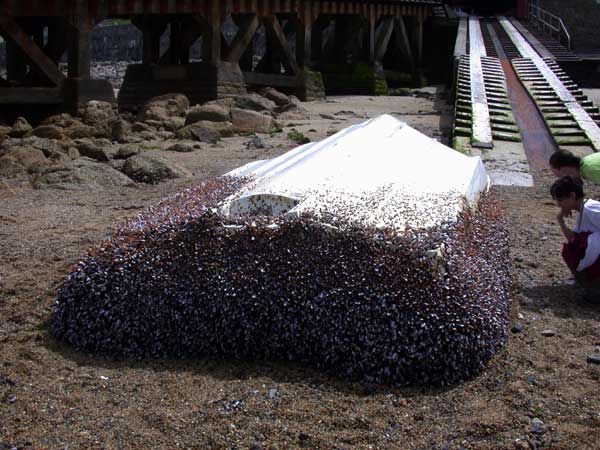 |
Atlantic Derelict
The appearance of this derelict fiberglass hull in June of 2003 near Land's End on the western coast of Great Britain drew local interest and also sparked an international e-mail based investigation into its origin. The boat had been adrift in a keel-up orientation for some time, as the enormous growth of barnacles and other marine life indicates.
PhotoCredit: Terry George, 5 June 2003 - Reference: 76-01 |
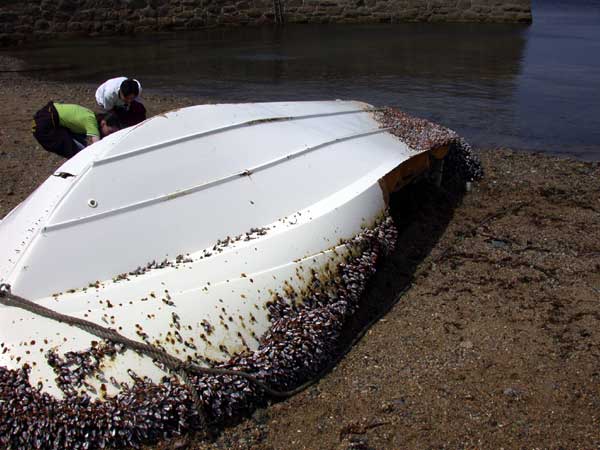 |
Atlantic Derelict
The water line in the inverted state is easily deduced from the marine growth. The starboard side has been sheared away, but otherwise the hull looks undamaged.
PhotoCredit: Terry George, 5 June 2003 - Reference: 76-01a |
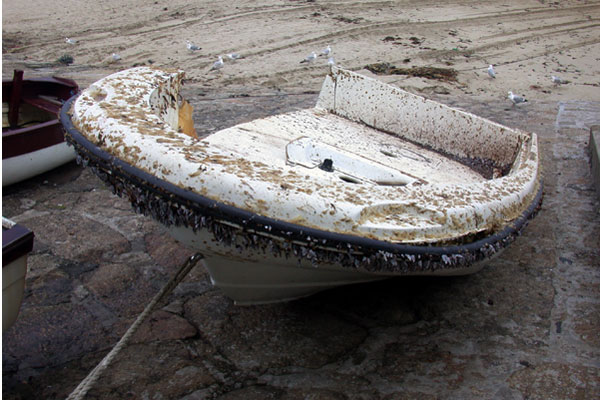 |
On the Beach
Hauled above the tide and surf line, the boat was flipped back onto her keel where the distinctive lines of a Boston Whaler became more apparent.
PhotoCredit: Terry George, 10 June 2003 - Reference: 76-02 |
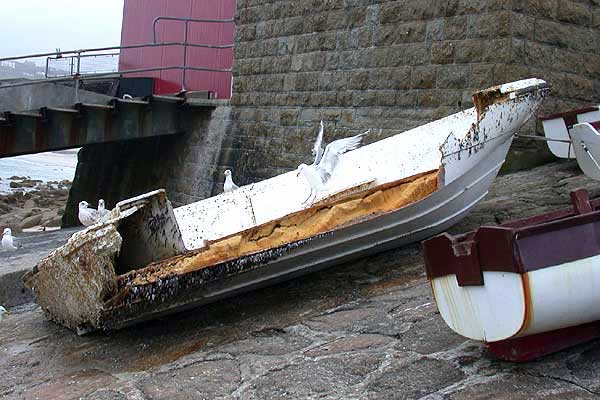 |
Unibond Construction
With this lengthwise slice of the starboard side removed, the unique Unibond foam construction of a Boston Whaler made identification certain. What other fiberglass boat would have been afloat this long? This seldom seen view of a newer Boston Whaler boat hull shows the enclosed bilge spaces formed by the three-piece topsides construction. Of course, the ultimate question: "Is the foam waterlogged?"
PhotoCredit: Terry George, 10 June 2003 - Reference: 76-03 |
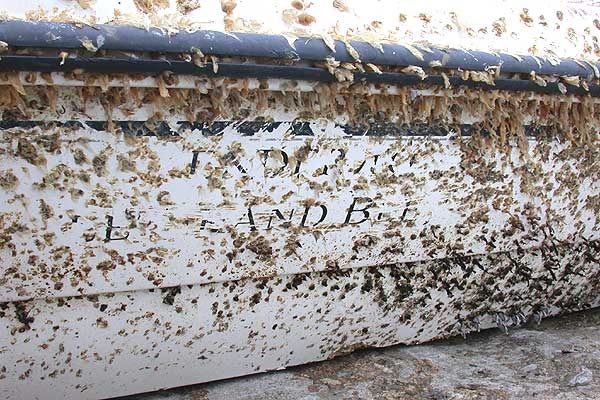 |
Topside Name
After scraping away a great deal of marine growth, the vessel's name could just be made out: TENDER to LE GRAND BLEU.
PhotoCredit: Terry George, 10 June 2003 - Reference: 76-04 |
I wrote back to Curt as follows:
"Hello Curt,
My opinion is that it is most likely a Boston Whaler hull based on
the foam filled construction and the hull shape. It appears to
be a fairly recent model as it has the Accutrack hull shape.
If you could remove the marine growth from the exterior of the transom
on the starboard side about 1-2 inches below the gunwale you should
find an embossed serial number that begins with BWC. The precise identity
of the hull can be deduced from this number.
I have taken the liberty of forwarding your initial message to
Mr. Chuck Bennett of the Boston Whaler company who I am sure
will be able to more accurately identify the boat and who
I am certain will favor you with an email reply.
Best regards,
--jimh
I soon got this reply:
Dear Jim:
Terry George did as you suggested and found the following code:
USBWCAM541 H900
Is it possible to find out who this was sold to? I suppose that is
confidential information?
Thanks for all your help.
Sincerely,
Curt
With the HIN number and help from Chuck Bennett at Boston Whaler, the identity of the boat
was soon confirmed. Additional investigation by Curt produced this narrative of the boat's
possible journey across the Atlantic, which with his kind permission we reproduce here:
Drift of the Derelict Dauntless
by Curtis C. Ebbesmeyer
927 days--Second Longest Drift of a Derelict Across the North Atlantic
Ocean
Land's End where England juts westward into the North Atlantic Ocean. On
Thursday, June 5, 2003, two merchant ships report a capsized skiff. By 0930
hours, rescuers launch a lifeboat from Sennen Cove. It's a false alarm--a
small white vessel eight miles southwest of Land's End. Massive colonies of
gooseneck barnacles echo a lengthy sea drift.
To avert further alarms, the search and rescue party towed the fiberglass
craft to shore. Next week, Cornwall's playwright-beachcomber Nick Darke
alerted me. Thus began my investigation of the second longest drift of a
derelict (a vessel abandoned at sea) on the North Atlantic!
Braving the stench of moldering barnacles, Terry George could barely
decipher TENDER TO LE GRAND BLEU on the port side of the skiff. Despite
missing most of its starboard side which would have sunk most vessels,
plastic foam sandwiched between its inner and outer plastic hulls kept the
boat afloat. Armed with Terry's photos, the tender's origin emerged from a
flurry of worldwide email.
Ed Perry, a park ranger at the McLarty Museum devoted to Spanish Galleons
wrecked along eastern Florida, immediately forwarded my query to Dr. Blair
Witherington, Florida Fish and Wildlife Conservation Commission and Florida
Marine Research Institute: "The boat has the gestalt of a Boston Whaler
(BW)." Blair's insight sent me internet surfing for the legendary builder
of unsinkable boats. Jim Hebert suggested BW's Chuck Bennett: "Given the
12-digit Hull Identification Number, I could find the original owner in BW's
data bank. This number is located on the outer transom towards the
starboard side."
"Found it - USBWCAM541 H900!," Terry emailed. From the ID, Chuck directed
me to Targa Yachten, BW's dealer in Hamburg, Germany. "We sold it in March
2000 as a tender for the Motor Yacht Le Grand Bleu (LGB) launched in Bremen,
Germany," replied John Argenton. "During summer 2000, LGB cruised to the
Mediterranean Sea. In November 2000, on a voyage to New York, heavy seas
washed the tender overboard into the mid-Atlantic."
From Terry's photos, John deduced that "Somebody found the tender before
stranding, cut the fuel hose and removed the engine, center console and
bench seat. The original Yamaha F100 four-stroke engine weighs about 361
pounds. If it came loose and dangled for a time, there should be some
damage at the stern, but I see none around the engine bolt holes or on top
of the engine well."
At 354 feet long, Le Grand Bleu is one of the world's ten largest yachts.
Accouterments include an aquarium, a 72-foot sailing yacht and a 68-foot
power launch. The 18-foot Dauntless rested on the foredeck ready to assist.
After the Atlantic storm, Le Grand Bleu steamed to New York leaving Dauntless adrift
on her epic voyage. Her odyssey ended in England while Le Grand Bleu cruised in the
Indian and Pacific oceans.
My experience with similar-sized transoceanic derelicts suggests Dauntless
drifted roughly ten miles a day. At this pace, the tender wandered more
than 9,000 miles! "An intrepid little tender," quipped Diane Byrne, Power &
Motoryacht magazine, "with a serious case of wanderlust."
The drift of the Dauntless is the second longest in North Atlantic history.
Phil Richardson, Woods Hole Oceanographic Institution, previously summarized
historic derelicts on the North Atlantic. During the late-1800s, storms and
accidents disabled hundreds. So many in fact, that to prevent collisions,
the U.S. Revenue Cutter Service routinely hunted and sank abandoned sailing
vessels. Phil discovered six which stayed afloat longer than a year and one
longer than 900 days--the schooner Fanny Wolston completed a circuit 'round
the North Atlantic gyre in 1,100 days.
Jim Boos, owners' representative onboard, looked up the tender's loss in
LGB's logbook. On November 20, 2000, in position 37.4° N, 60.1° W Le Grand Bleu encountered
Force 8-9 weather. Four hundred miles northeast of Bermuda, gales and high
waves swept the Dauntless into the Bermuda Triangle. Dealing with a special
drift spurred me to further investigate.
Given the initial latitude and longitude, charts of mean ocean currents for
fall as well as trajectories of Gulf Stream rings from that area indicate
that the tender may have looped southwest toward Florida. The mean transit
for messages in bottles from Florida to England is 14 months leaving 16
months for Dauntless to meander about the Sargasso Sea. Trajectories of
historic derelicts also suggest she might have zig-zagged eastward to the
Azores.
Where and when did the salvers strip the tender? Early in the odyssey, I'd
guess. Within months, marine conditions would have rendered the engine
worthless. Furthermore, if it hung very long from the stern, waves would
have wrenched the engine mountings. As the storm tossed the tender
overboard from LGB, I suspect violent lurching snapped off the tender's
side. Salvers, finding her gravely damaged, claimed all of value.
Weather charts and sea surface temperature maps may help ascertain
Dauntless' drift. With substantial windage, however, the skiff traveled
faster than surface water. Furthermore, the windage changed over time given
the barnacle growth and removal of the engine. With so many assumptions
necessary for an accurate drift reconstruction, I suspended my research.
Dauntless returned me to childhood when my mother read aloud The Little
Engine That Could. The little tender that could...and did!
"In the right light, at the right time,
everything is extraordinary." - Aaron Rose
More Photographs
More photographs showing some of the details mentioned above:
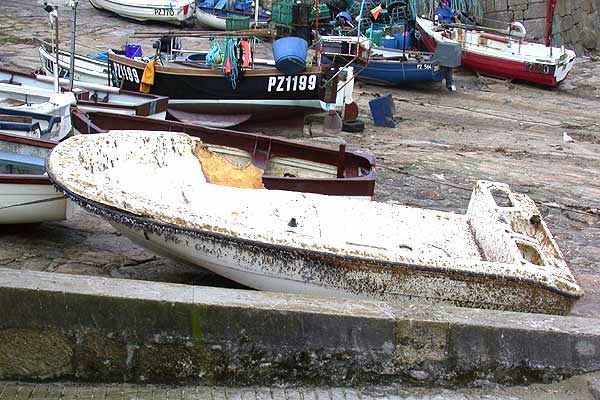 |
Missing Parts
The boat's center console, helm seating, hatches, railings, navigation lights, cleats, and outboard motor are all missing. The presumption is that they were removed by a previous salver and the stripped hull set back adrift on the Atlantic.
PhotoCredit: Terry George, 10 June 2003 - Reference: 76-05 |
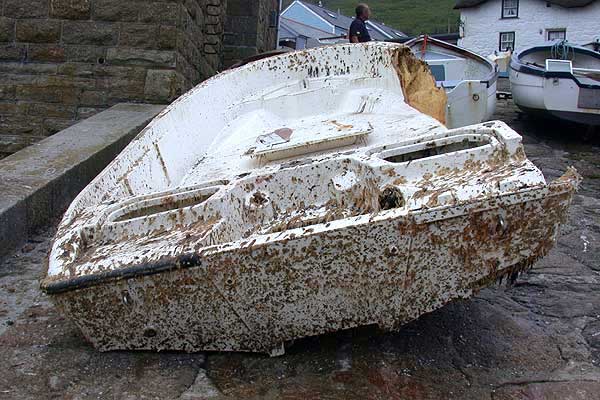 |
Missing Outbard
The transom appears undamaged, further evidence the engine and its rigging were carefully removed at some point.
PhotoCredit: Terry George, 10 June 2003 - Reference: 76-06 |
 |
Stripped Bilge
Clean cuts of fuel lines and other bilge plumbing were made by something other than the sea itself.
PhotoCredit: Terry George, 10 June 2003 - Reference: 76-07 |
 |
Marine Life
Barnacles and other marine life found a comfortable home on the derelict hull during its 30 months of drift across the Atlantic Ocean.
PhotoCredit: Terry George, 10 June 2003 - Reference: 76-08 |
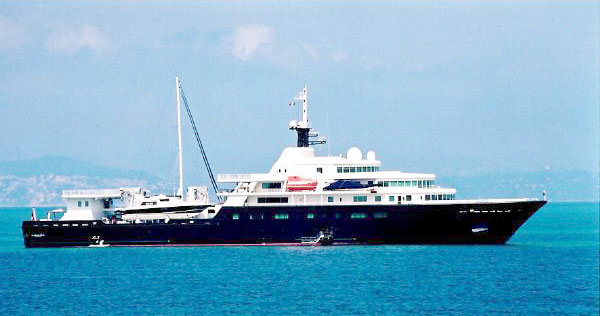 |
Le Grand Bleu
Le Grand Bleu was seen recently in the Mediteranean. She is designed as an "expedition yacht," capable of making long independent voyages. As seen here, she carries a 72-foot sailing yacht and an 68-foot motor yacht among her auxiliary vessels on board.
PhotoCredit: Chris Suffeleers - Reference: 76-09 |
More Information
While preparing this article, I just received these additional comments from Terry George:
Hi Jim,
The boat was found by the Sennen Cove lifeboat (of which I am the Coxswain)
after we were launched on a search-and-rescue mission following reports of
the sighting of a capsized boat near the Wolf Rock lighthouse, some 8 miles
southwest of Land`s End. We immediately realised that the boat had been in
the water for a long time and it was extremely unlikely anyone was in
trouble at that time.
We towed the boat, inverted, slowly back to Sennen Cove , where it remains
today in unaltered state.
Also noted, Paul Allen of Microsoft is often attributed as the owner of Le Grand Bleu
but this may be a myth. Cellular telephone pioneer John McCaw is thought to have had the
fabulous expedition yacht built. Who
really knows?
Most recently, Russian oil billionaire
Roman Abramovich
has been cited as the owner, possibly having bought her in July of 2003.
Now reported as the 6th largest private yacht
in the world, Le Grand Bleu
may be slipping in the rankings as word comes of more 400-foot "giga-yachts" now being
built. They will probably have Boston Whaler's for their tenders, too.
In all, it is a quite amazing story that shows two most interesting things: the unsinkable
nature of a Boston Whaler hull, and how much of a global village our world has become.
Many thanks to Terry and Curt for their permission to use their work in these pages.
continuousWave --> Whaler --> Cetacea
Previous | Next
DISCLAIMER: This information is believed to be accurate but there is no guarantee. We do our best!
The page has been accessed 95890 times.
Copyright © 2003 by James W. Hebert. Unauthorized reproduction prohibited!
This is a verified HTML 4.0 document served to you from continuousWave
URI: http://continuouswave.com/whaler/cetacea/cetaceaPage76.html
This article first appeared December 28, 2003.
Last modified: Wednesday, 16-Jan-2008 22:24:46 EST
Author: James W. Hebert

![[Logo: WHALER CETACEA]](graphics/cetaceaLogo230x60Trans.gif)








